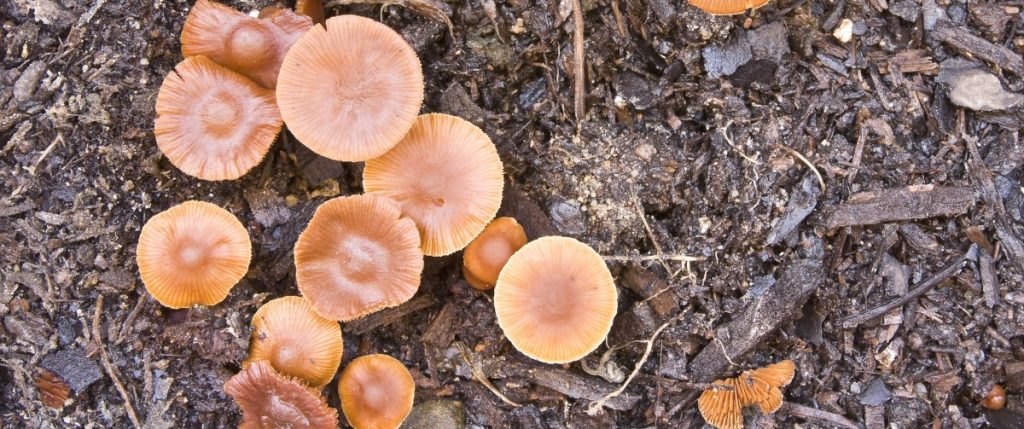It takes time for organic material to fully decompose, and during this time, people often discover mushrooms growing in their compost pile or bin and wonder why.
In this article, you’ll discover answers to all your questions about mushrooms growing in compost.
We also look at the benefits and dangers of mushrooms growing in compost and what to do about them.

Why Are Mushrooms Growing in My Compost?
Cooler temperatures, high moisture levels and lots of decaying wood and leaves create perfect conditions for mushrooms and other fungi to grow.
So, sometimes after heavy rain or if you live in an area with a cool, humid climate, you’ll notice mushrooms in your compost pile or bin.
Some mushrooms grow very fast and seem to appear overnight.
But, the mushrooms you see are the fruiting bodies of a larger hidden fungus growing in your compost and helping to decompose the woody cellulose material.
The ideal conditions for mushroom producing fungi to grow are:
- high humidity
- indirect light
- good airflow
- temperatures of around 64 to 75°F (18 to 24°C)
Although ideal temperatures vary depending on the species of mushroom.
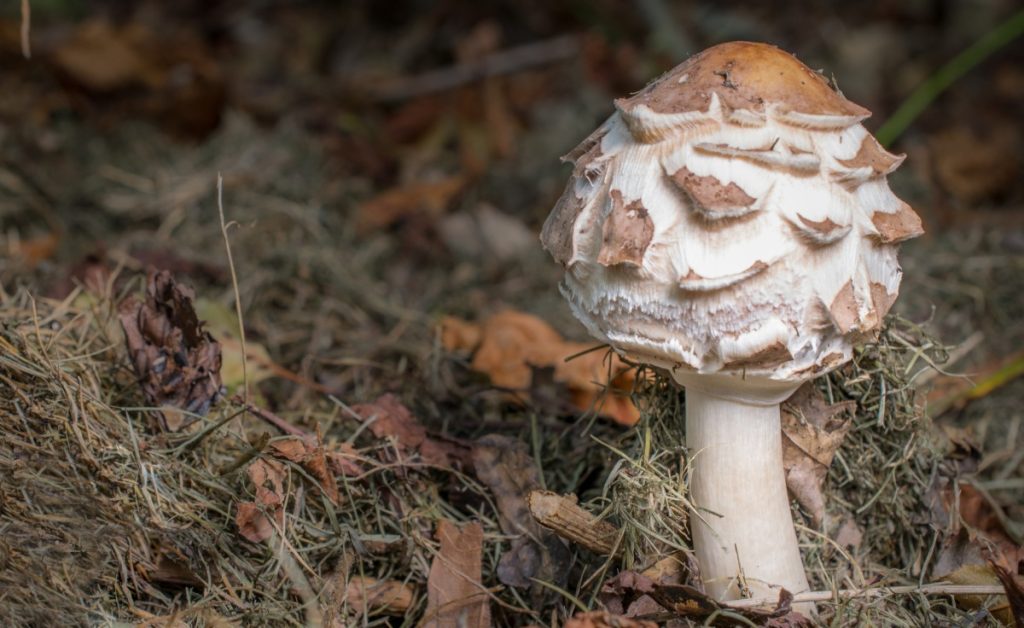
Is Fungus Bad for Compost?
Fungi of all kinds play a role in the decomposition of organic material. So, having them in your compost is not a bad thing, and it may even help speed up the composting process.
Not all fungi are the same, and while mushrooms are all fungi, not all fungi produce mushrooms. The fungi kingdom includes molds, rusts, yeasts, mildews, and smuts.
Both molds and mushrooms are commonly found in moist compost with lots of decomposing material.

Why Are There Mushrooms Growing in my Potted Plant?
It is not unusual to see mushrooms growing in potted plants, especially if they have potting mix or soil that’s rich in organic matter.
And, like the mushrooms that appear in compost, they’re not bad and will not harm your pot plant. They’re merely helping with the decomposition of the organic matter in the potting mixture.
The potting mixture you purchase for your potted plant may contain fungal spores, tiny single-cell organisms, that mushrooms use to reproduce.
But, that’s not the only way for spores to get into your pot plant. Tiny spores floating in the wind may land in your pot or even rub off clothing or pets.
One of the most common types of mushroom found in pot plants is the pot plant dapperling (Leucocoprinus birnbaumii) which enjoys warm, humid conditions.
This is unlike the backyard mushrooms growing in your lawn that enjoy cool, moist conditions.

What Kind of Mushrooms Grow in Compost?
Different species of mushrooms feed on different organic materials in various stages of decomposition.
Primary decomposers like shiitake and oyster mushrooms feed on newly dead or just-cut trees.
Then you get the litter decomposers like wine cap stropharia that feed on decomposing wood chips and leaf litter.
Followed by mushrooms like blewits that thrive on decomposing organic garden and yard waste material.
And at the final stage, you have the secondary decomposers that grow on finished compost.
These include button, cremini and portabella mushrooms that people usually grow on compost created using a mix of straw with horse or chicken manure.
So, depending on the type of organic material and its stage of decomposition, you could find several species of mushroom in your compost.
You can also use your compost pile or finished compost to grow your own edible mushrooms, including:
Wood Blewit (Clitocybe Nuda)
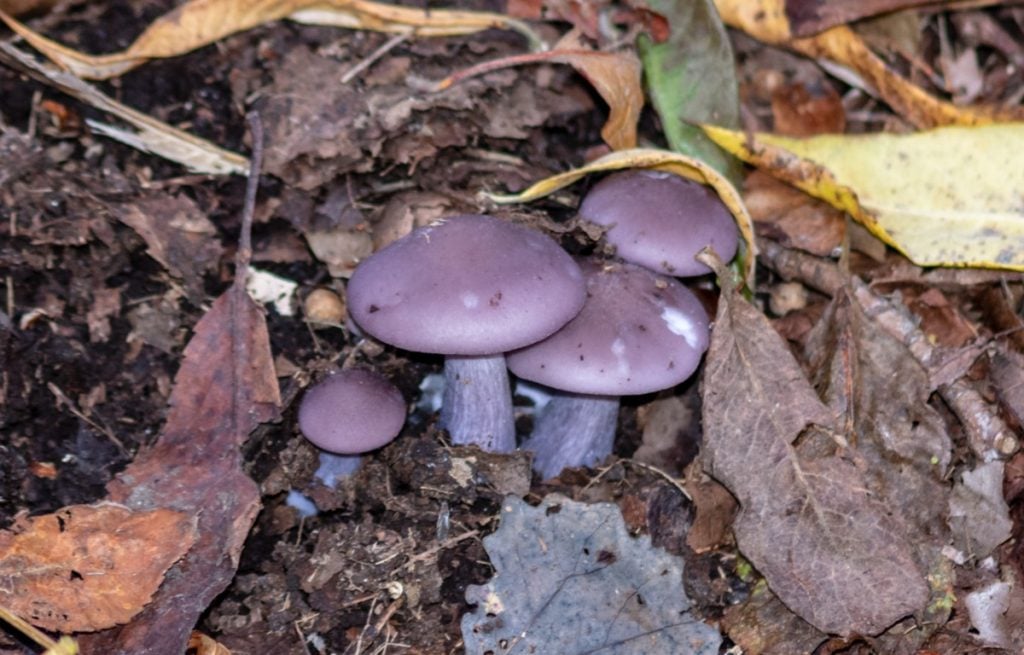
These beautiful edible mushrooms come in varying shades of blue, lavender and pink.
In the wild, they grow in decaying leaf litter in mixed woodland and prefer feeding on organic matter that is already slightly decayed.
This preference makes them perfect for growing in your compost pile or even straight in a well-mulched garden bed.
You can grow blewits on a wide variety of semi-composted organic materials, including yard waste, leaves, twigs, grass clippings, hay, etc.
They fruit in fall, and it takes a year from the time you introduce blewit spawn to your compost to get your first flush.
Wood blewits have a distinctive, earthy flavor and dense texture and are delicious sauteed in butter or used in omelets or stews.
Wine Cap Stropharia (Stropharia Rugosoannulata)

These large mushrooms have a slightly nutty flavor and a crisp texture.
They’re one of the easiest mushrooms to grow and great for beginner mushroom growers who want to grow mushrooms outdoors.
Also called the king stropharia or garden giant, they’re fast-growing, hardy litter decomposers that grow on all sorts of woody debris.
They can tolerate a range of environmental conditions and even some sun which makes them unique.
When used in well-mulched vegetable gardens, they often increase a crop’s yield.
You can use wine cap mushrooms in various dishes, and they’re a good substitute for cremini or portobello mushrooms in recipes.
Shaggy Ink Cap (Coprinus Comatus)

You can grow shaggy ink caps, also called a shaggy mane, in a compost pile or manure-enriched soil.
They enjoy active compost piles but won’t survive when it reaches higher temperatures.
Remember to check on them regularly, as you need to harvest shaggy ink caps when young and use them within a few hours. Because, as soon as you pick them, they begin to autodigest.
They’re delicious and have a mild asparagus-like flavor, but as they don’t have a shelf life, they’re unsuitable for a mushroom growing business.
But they could be fun to try if you like to experiment with growing different types of mushrooms.
Almond Mushroom (Agaricus Subrufescens)
This delicious cousin of button, cremini and portabella mushrooms has a distinct almond aroma and slightly sweet almond flavor.
Like its cousins, it grows on finished compost but is much easier to grow and thrives on a broad range of homemade compost.
It’s a summer fruiting mushroom that enjoys warmer weather but is hardy enough to survive lower temperatures near the end of summer.
To grow these mushrooms, bury chunks of mushroom spawn in a 5 inch (13 cm) layer of compost in a shady spot, then add mulch and water.
It’s important to keep the compost moist during the incubation period.
Planting them between other leafy plants or vegetables helps maintain humidity levels once they fruit.
Almond mushrooms can give you three to five flushes of mushrooms in a season, but the first flush will be the largest.
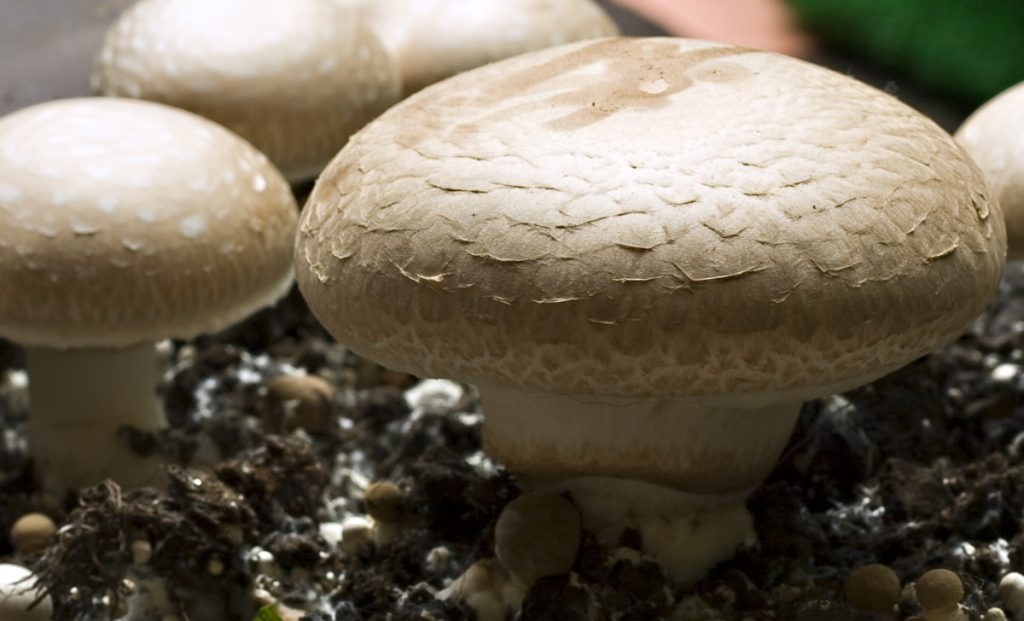
Benefits of Mushrooms Growing in Compost
There are several benefits of having mushrooms growing in your compost, including:
1. Speeding up The Decomposition Process
In nature, fungi play a vital role in breaking down dead and decaying organic matter. And they excel at breaking down tougher materials like lignin and cellulose.
The mushrooms in your compost heap help speed up the decomposition of woody materials like leaves and vegetable and fruit skins.
2. Creating Mycelium Networks
If you have mushrooms growing in your compost, your compost pile or bin is full of thread-like fungal mycelium.
Mycelium creates a network in the compost pile that helps spread nutrients throughout the compost.
When you add mycelium-rich compost to your garden, the fungi improve the soil’s ecosystem and help it retain moisture.
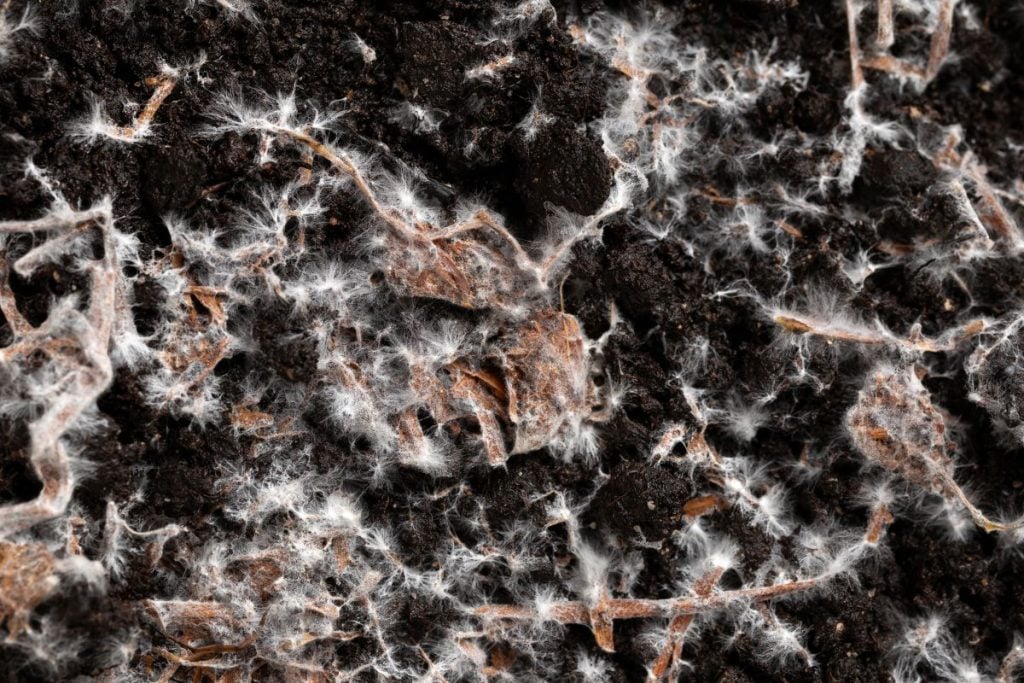
3. Providing Nutrients and Minerals
Many mushrooms are superfoods and good sources of vitamin D, copper, phosphorus, potassium, selenium and more.
As the mushrooms growing in your compost break down, they release these nutrients.
This process enriches the finished compost, providing more nutrients for your plants.
Dangers of Mushrooms Growing in Compost
Not all mushrooms are edible, and several species are extremely poisonous, sometimes even lethal.
If you have children or pets and have unidentified mushrooms growing in your compost, it’s best to remove them and bury them in the center of the pile or safely dispose of them.
This will not kill the fungus growing in your compost but will prevent spores from spreading and keep your pets and children safe.

How do I get rid of mushrooms in my compost bin?
If you want to prevent mushrooms from growing in your compost bin, there are a couple of things you can try:
- Make sure you have enough nitrogen-rich, “green” organic materials, like kitchen scraps, to balance the “brown” leaves and branches that the fungi feed on.
- Turn your compost heap frequently. Doing this helps to break up any mycelial networks growing in the compost.
- Try adding worms and vermicomposting. The constant movement and tunneling of the worms helps break apart mycelium, preventing the fungi from fruiting.
- Use the hot composting method and maintain temperatures of 141 to 155°F (60 to 68°C). Mushrooms won’t grow in your compost as they cannot survive at these temperatures.

Can You Compost Mushrooms?
Yes, you can compost mushrooms, and both edible and wild mushrooms are compostable.
Adding whole wild mushrooms or edible mushroom trimmings and stems to your compost aids decomposition and enriches the compost with essential minerals.
The best way to add mushrooms to your compost pile is to dig a hole in the middle and add the mushroom scraps.
Include other “green” compost ingredients, like vegetable scraps or coffee grounds, to help speed up decomposition.
Then cover them with grass clippings or leaves to prevent young children, pets or other backyard pests from finding them.
What is Mushroom Compost?
The term mushroom compost can be a little confusing.
In some instances, it refers to the compost created to grow compost-loving button, cremini and portabella mushrooms.
But, more commonly, the term mushroom compost describes compost for use in a garden.
You’ll generally find mushroom compost sold in bags labeled spent mushroom substrate (SMS) or spent mushroom compost (SMC).
These bags contain the mycelium-rich substrate or growing medium leftover after mushroom growers harvest their mushrooms.
Growers create substrates using various organic materials, and substrate recipes vary from grower to grower.
But, when added to your garden soil, they all act as slow-release organic plant fertilizers.

Can You Eat Mushrooms That Grow From Mushroom Compost?
If you are one hundred percent sure and have positively identified the mushrooms as edible, you can eat them.
Often mushroom compost or substrate is not entirely “spent” but rather no longer viable for producing large quantities of mushrooms.
And when placed in the right conditions, mushrooms often grow in mushroom compost.
If you keep your compost in the bag and place it in fruiting conditions, you may get a few flushes of delicious mushrooms.
But, when removed from sterile conditions, it does not take long for mushroom compost to get overrun by other types of fungus.
If you spread mushroom compost in your garden, you need to be extremely careful and positively identify any mushrooms that appear.
As inedible, wild mushrooms may also grow in the mushroom compost.
Mushroom identification apps can help you with this. But if you are even slightly unsure, it’s safer not to eat them.
Final Thoughts
Mushrooms growing in your compost are not bad and often provide several benefits.
But, as many mushrooms are poisonous, you need to be cautious, especially if they’re in reach of children or pets.
If you want to try growing mushrooms at home, you can use your compost pile or well-composted garden beds to grow delicious edible mushrooms.
Learn more about different types of mushrooms or visit our Mushroom Growing Hub for comprehensive guides on growing mushrooms at home.
